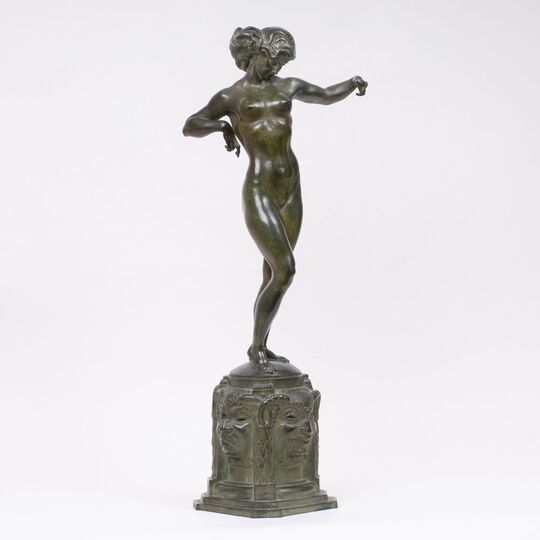'Comedy' or 'The Four Temperaments'
Ferdinand Liebermann (Judenbach/Thür. 1883 - München 1941), sculptor

Lot-No. 740
Proceeds : 8.800 €
Around 1913. bronze, green-black patinated. On the plinth sign. 'FERDINAND LIEBERMANN'. In the base old newspaper clipping from 1941 on the occasion of Liebermann's death. H. 61 cm. - The figure, of which at least seven further casts are known, was first shown under the title 'Comedy' at the 1913 Intern. Kunstausst. in the Kgl. Glaspalast in Munich and in 1914 at the Große Berliner Kunstausst. in Berlin. The four character reliefs on the pedestal symbolise the theory of temperaments known since antiquity, which categorises people according to four basic temperaments: the sanguine, the choleric, the melancholic and the phlegmatic. - Literature: Illustrated cat. of the XI Intern. Kunstausst. im Kgl. Glaspalast zu München 1913, current no. 1870, p. 109 and ill. plate 166; Cat. Grosse Berliner Kunstausst. 1914, plate 156. - Provenance: North German private property since the 1st half of the 20th century. - German sculptor, trained at the Kunstgewerbeschule and Academy in Munich (under Heinrich Waderé). After studies in Rome and Paris, L. opened his studio in Munich in 1910 and was awarded the Great Austrian State Medal in Gold for a small bronze in the same year. In 1926 he was appointed professor for monumental and portrait sculpture in Munich, and during the Nazi era he received numerous state commissions. His work includes numerous architectural sculptures, monuments and fountains, and he was also one of the most important figure designers for the Rosenthal manufactory.
Ferdinand Liebermann: 'Comedy' or 'The Four Temperaments'
Ferdinand Liebermann (Judenbach/Thür. 1883 - München 1941), sculptor
'Comedy' or 'The Four Temperaments'
Lot-No. 740
Proceeds : 8.800 €
Around 1913. bronze, green-black patinated. On the plinth sign. 'FERDINAND LIEBERMANN'. In the base old newspaper clipping from 1941 on the occasion of Liebermann's death. H. 61 cm. - The figure, of which at least seven further casts are known, was first shown under the title 'Comedy' at the 1913 Intern. Kunstausst. in the Kgl. Glaspalast in Munich and in 1914 at the Große Berliner Kunstausst. in Berlin. The four character reliefs on the pedestal symbolise the theory of temperaments known since antiquity, which categorises people according to four basic temperaments: the sanguine, the choleric, the melancholic and the phlegmatic. - Literature: Illustrated cat. of the XI Intern. Kunstausst. im Kgl. Glaspalast zu München 1913, current no. 1870, p. 109 and ill. plate 166; Cat. Grosse Berliner Kunstausst. 1914, plate 156. - Provenance: North German private property since the 1st half of the 20th century. - German sculptor, trained at the Kunstgewerbeschule and Academy in Munich (under Heinrich Waderé). After studies in Rome and Paris, L. opened his studio in Munich in 1910 and was awarded the Great Austrian State Medal in Gold for a small bronze in the same year. In 1926 he was appointed professor for monumental and portrait sculpture in Munich, and during the Nazi era he received numerous state commissions. His work includes numerous architectural sculptures, monuments and fountains, and he was also one of the most important figure designers for the Rosenthal manufactory.


